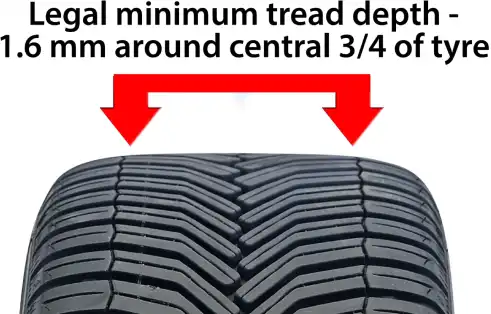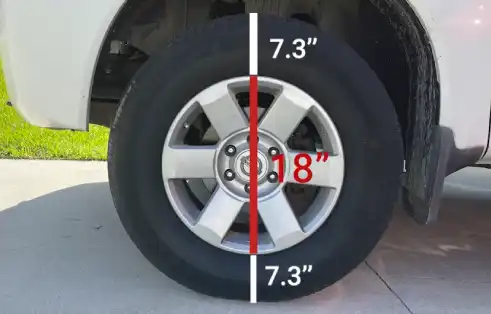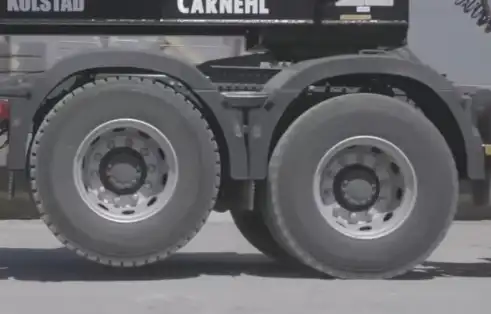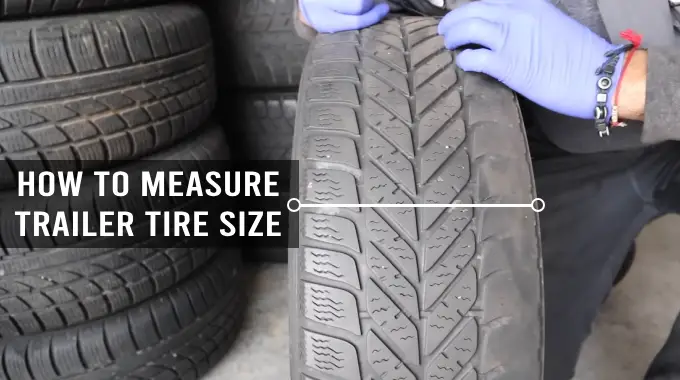Last Updated on September 25, 2023
Did you know that there are over 9 million registered trailers in the United States? With such a large number of trailers on the road, you should know how to properly measure the size of your trailer tires.
To begin with, you need to measure the tire width, which can be done by taking a measuring tape and measuring the distance from one side of the tire to the other. Next, you’ll want to calculate the sidewall height by measuring the distance from the rim to the tread and multiplying it by 2.
Finally, determine the rim diameter by measuring across the wheel’s center. Also, it’s important to assess the load capacity and evaluate the speed rating of the tires to ensure they’re suitable for your trailer.
Here, we will guide you through the steps of measuring your trailer tire size accurately. We will cover the two types of trailer tires, the number of tires typically found on a trailer, and the importance of the tire ply rating.
Steps on How Do You Measure Trailer Tire Size

When measuring the size of your trailer tires, there are several key points to consider.
- Step 01: Tire Width Measurement
- Step 02: Sidewall Height Calculation
- Step 03: Rim Diameter Determination
- Step 04: Tread Depth Measurement
- Step 05: Overall Tire Diameter
- Step 06: Matching Trailer Specifications
- Step 07: Proper Tire Selection
Step 01: Tire Width Measurement
To measure the width of your trailer tire, you’ll need to use a simple technique. Start by locating the tire’s sidewall, where you’ll find numbers and letters. Look for the section that indicates the tire width. It’ll typically be labeled as ‘Width’ or ‘W.’
Once you’ve identified this section, follow these steps to measure the width for confirmation:
- Use a measuring tape or ruler with millimeter increments.
- Place the tape or ruler across the tire’s width from one sidewall to another.
- Ensure the measuring tool is parallel to the ground and aligned with the center of the tire.
- Read the measurement in millimeters.
- Write down the width measurement for future reference.
Step 02: Sidewall Height Calculation
Now let’s find out how to calculate the height of your tire’s sidewall. This step is crucial in determining the overall size of your trailer tire.
To start, locate the letters ‘ST’ on the sidewall of your tire, which stands for ‘Special Trailer.’ Next, locate the number that follows the ‘ST’ letters. This number represents the sidewall height as a percentage of the tire’s width. For example, if the number is 75, it means that the sidewall height is 75% of the tire’s width.
To calculate the sidewall height in inches, multiply the tire width by the sidewall height percentage and divide it by 100. This will give you the precise measurement of your tire’s sidewall height.
Step 03: Rim Diameter Determination
Determining the rim diameter is an essential step that allows you to choose the perfect fit for your trailer, ensuring you’re on the right track to a smooth ride. To determine the rim diameter, follow these steps:
- Measure the distance across the center of the wheel from one edge to the opposite edge. This measurement will give you the rim diameter in inches.
- Use a measuring tape to accurately determine the diameter. Make sure to measure at the widest point of the rim, which is typically near the tire bead.
- Take note of the measurement and round it to the nearest whole number. This will be your rim diameter, crucial information when selecting new trailer tires.
Step 04: Tread Depth Measurement
As you run your fingers along the surface of the tire, you can feel the deep grooves and imagine the tire’s ability to grip the road, ensuring a safe and stable ride.
Tread depth is an important factor in determining the performance and longevity of your trailer tires. To measure the tread depth accurately, you’ll need a tread depth gauge. Place the gauge into the tire grooves and press it down until it reaches the base of the groove. Read the measurement on the gauge to determine the tread depth.
It’s recommended to have a tread depth of at least 4/32 of an inch for trailer tires. If the tread depth is below this threshold, it may be time to replace the tires to maintain optimal performance and safety on the road.
Step 05: Overall Tire Diameter

After you’ve confirmed the tire width, sidewall height, and tread depth of your trailer tires, you should also measure the overall tire diameter. This number is usually found on the sidewall of the tire, but if it’s not present, simply divide the width by two and then add the sidewall height to get this measurement.
The overall tire diameter will provide you with important information about how well your vehicle will perform on the road. Having tires with appropriate size will ensure optimal handling and a smooth ride.
Step 06: Matching Trailer Specifications
After you have the overall tire diameter, you should make sure that this number matches up with your trailer’s specifications. If they don’t match, your tires won’t fit properly and may cause safety hazards when towing.
Finding the perfect match for your trailer’s specifications is the key to a seamless and satisfying towing experience. To ensure that the tire size is suitable for your trailer, it’s crucial to match it with the manufacturer’s recommendations.
This information can typically be found in the owner’s manual or on a placard on the trailer’s body. Pay attention to the load range, which indicates the maximum weight capacity of the tire. Choosing a tire with the appropriate load range is essential to ensure safe and efficient towing.
Consider the tire’s speed rating as well, which indicates its maximum speed. By adhering to the manufacturer’s specifications for your trailer, you can ensure optimal performance and safety while on the road.
Step 07: Proper Tire Selection
Finally, you can now select the appropriate tire for your trailer. Consider the trailer’s axle weight and total weight capacity when making your selection. Selecting tires with a load range or ply rating sufficient enough to support your trailer’s load is important.
Additionally, look for tires with speed ratings higher than what the trailer will actually need. This will give you an extra margin of safety while on the road.
Once you have identified the right tires for your trailer, it’s time to make the purchase. Check with local tire dealers or online retailers for pricing and availability. With care and proper maintenance, your new tires should give you reliable service for many miles of travel.
Additional Factors to Consider When Measuring Your Trailer Tires Size
There are a few other factors to consider besides just the load range and speed rating when you purchase a new trailer tire when measuring its size.
No 01: Load Capacity Assessment
Make sure you assess the load capacity of your trailer to ensure a safe and reliable hauling experience. The load capacity refers to the maximum weight that your trailer can safely carry. It is possible to exceed the size limitations of your trailer tires without measuring this weight.
Exceeding this limit can lead to tire damage, decreased stability, and increased risk of accidents. Refer to your trailer tire’s load index to find out how much weight it can support. This information is usually found on the tire sidewall.
Through the load capacity assessment, you will ensure your tire size is correct for the load that your trailer will be carrying.
No 02: Speed Rating Evaluation
To ensure a safe and thrilling hauling experience, evaluate the speed rating of your trailer tires when measuring tire size. Exceeding the recommended speed can increase the risk of accidents.
Tires with a higher speed rating are designed to withstand higher speeds, making them more suitable for highway driving. These size tires have reinforced sidewalls and advanced tread designs to enhance stability and grip at high speeds.
When hauling heavy loads, it’s crucial to have tires with a speed rating that matches your trailer’s weight and speed requirements.
No 03: Tire Pressure Examination
Checking the tire pressure is crucial for measuring a trailer tire size and maintaining optimal performance and safety on the road. To ensure accurate measurements, follow these steps:
- Measure the air pressure with a tire pressure gauge.
- Remove the valve cap from the tire.
- Place the gauge onto the valve stem and press down firmly.
- Read the measurement on the gauge display.
- Compare the measurement to the recommended tire pressure specified by the manufacturer.
Underinflated tires can lead to increased fuel consumption, decreased tire lifespan, and poor handling. On the other hand, overinflated tires may result in reduced traction, uneven wear, and a harsh ride.
What are the two types of trailer tires?

There are two types of trailer tires: radial and bias-ply, each with its own unique characteristics.
Radial trailer tires are constructed with layers of steel belts running across the tread, allowing for better traction and stability. They have a flexible sidewall, which helps in reducing heat build-up and increases fuel efficiency.
This type of tire is known for its smooth ride and durability, making it a popular choice for long-haul trips.
On the other hand, bias-ply trailer tires are made with multiple layers of crisscrossed nylon or polyester cords. This construction gives them a stiffer sidewall, providing better load-carrying capacity and puncture resistance.
Bias-ply tires are more affordable compared to radials, making them a suitable option for trailers that are used less frequently or in off-road conditions.
Can Grounding a Generator on a Trailer Help with Measuring Trailer Tire Size?
Grounding a generator on a trailer does not directly affect the measurement of trailer tire size. However, proper grounding is crucial for electrical safety when operating a generator on a trailer. To determine tire size, it is advisable to refer to the trailer’s specifications or consult a professional.
How many tires are in a trailer?
While trailers come in various sizes and configurations, it’s fascinating that the number of tires on a trailer can range from four to eight, depending on their weight and design.
The number of tires is primarily determined by the weight the trailer needs to support. For lighter trailers, you’ll typically find four tires, with two tires on each axle. These trailers are designed to carry lighter loads and are commonly seen in recreational and utility trailers.
On the other hand, heavier trailers, such as those used for hauling goods or construction materials, may have six or even eight tires.
These trailers usually have tandem axles, which means two axles are spaced closely together, each with two or four tires. The additional tires provide increased stability and weight distribution, allowing the trailer to safely carry heavier loads.
It’s important to note that a trailer’s tire count is not solely determined by its weight but also by its design. Some trailers may have additional tires for added durability and strength, especially if they’re used in off-road or challenging terrain conditions.
The tire size may also vary depending on the trailer’s weight and the manufacturer’s specifications.
What is the trailer tire ply rating?
When choosing the appropriate trailer tire, it’s essential to consider the ply rating, which indicates the strength and load-carrying capacity of the tire you need. The ply rating refers to the number of layers of fabric or cords within the tire.
The higher the ply rating, the stronger the tire and the greater its ability to carry heavy loads. Here’s what you need to know about trailer tire ply ratings:
- Ply Ratings: Trailer tires come in different ply ratings, ranging from 4 to 14. For example, load Range C tires have a 6 ply rating, Load Range D tires have an 8 ply rating, and Load Range E tires have a 10 ply rating. The higher the ply rating, the more durable and robust the tire.
- Load-Carrying Capacity: Each ply rating corresponds to a specific maximum load pressure. Load Range C tires have a maximum load pressure of 50 psi (350 kPa), Load Range D tires have a maximum load pressure of 65 psi (450 kPa), and Load Range E tires have a maximum load pressure of 80 psi (550 kPa).
Mastering Trailer Tire Measurements
Properly measuring the size of your trailer tires is crucial for ensuring safety, performance, and a smooth towing experience. Following the steps outlined in this guide, you can accurately determine the tire width, sidewall height, rim diameter, tread depth, and overall tire diameter.
Matching these measurements with your trailer’s specifications, load capacity, and speed rating will help you select the right tires for your trailer. Additionally, considering factors like the tire ply rating, tire pressure and choosing between radial and bias-ply tires are important for optimal performance and longevity.
By taking these measurements and factors into account, you can make informed decisions when selecting and maintaining trailer tires, ensuring safe and reliable travels on the road.



